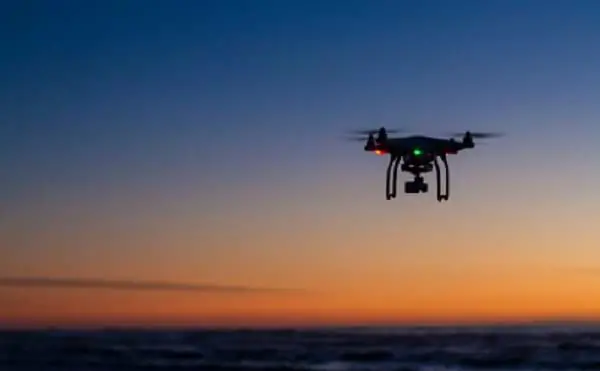
As drone enthusiasts, we are always looking for chances to fly our drones and usually, this time is during the day when we can see our drones. But are you allowed to also fly your drone at night? Well, I did some research, and here is what I found out.
If you are flying a drone for recreation purposes as a hobby drone pilot, then according to the FAA, (Federal Aviation Administration,) you can fly your drone at night. But only if your drone has enough lighting for you to maintain a visual line of sight, and for you to keep the orientation of the drone at all times.
But there’s more you should know. Keep reading to find out everything you need to know about flying your drone at night so you don’t run into any trouble!
Important Things You Need To Know: Flying Drones at Night
There is still a lot of confusion about flying drones at night with a lot of people getting in trouble because of not doing their research properly.
In this article, I will go over what you need to do in order to be able to fly your drone at night as a hobbyist, and I will also give you the different rules and guidelines you need to follow in order to make sure that you do not get into any trouble while flying your drone.
Even though you can fly at night, you still need to make sure you follow these important drone laws.
Rules For Flying a Drone at Night:
- Only fly the drone for hobby or recreational purposes. In other words, don’t use it to try and make money.
- Always fly the keep the drone within visual line-of-sight.
- Follow the set of guidelines set by your community.
- Always give way to manned aircrafts such as planes and helicopters.
- Provide prior notification to airports and towers that are in the area about your flight. This usually applies if you’re within a 5-mile radius of an airport.
- Only fly a drone that weighs under 55lbs unless you are certified to fly a drone over that weight limit.
Tips For Flying a Drone at Night
Flying drones at night can be very dangerous because there’s a higher risk of losing sight of your drone. On top of that, it’s difficult to see if there are objects nearby that may end up in your drone’s flight plan. Here are some ways you can fly as safely as possible.
Perform a Preflight Inspection on Your Drone.
One thing you need to do before flying your drone at night is to prepare it. How would you do this? You can do this by performing a preflight inspection on your drone and making a checklist that you can complete before the flight.
You need to make sure that the drone you are flying at night has a lighting system that is suitable and that meets FAA requirements.
Know Your Surroundings.
The first thing you need to do before you fly your drone is to make sure that you know the area you will be flying your drone in very well.
This helps in many ways. By flying in an area you are familiar with, you reduce the risk and probability of you crashing into obstacles because you would know or at least have an idea of where these obstacles are.
Obstacles can include buildings, trees, telephone poles, etc. These things can look like a blur when flying in the dark, but if you are familiar with the area then you at least know what to look out for.
Remain Vigilant.
This might be one of the most important tips that I can give you for when you fly a drone at night. It is very important to watch where your drone is going and keep an eye on the surroundings.
Many drone pilots, including myself, tend to get a little distracted by the view from our mobile devices and the shot we are trying to get and end up ignoring the drones trajectory and the tree that is in the way!
Remove Any ND Filters.
The ND filter, or the Neutral Density filter, is the filter on the drones camera lens that reduces or modifies the intensity of all colors of light equally. It’s like sunglasses for your drone. If you are planning to take pictures or video at night, make sure you remove these “sunglasses” so that the images don’t come out too dark.
Increase Your Altitude.
When flying at night it is always best to increase the altitude you are flying at. When flying at night its best to fly higher than you normally would just to avoid any obstacles you might have not noticed or obstacles that were recently added to the area.
Watch Your Drone.
This might seem like a very obvious thing to say but keep an eye on your drone. When flying a drone at night compared to the visibility you have during the day, it is next to nothing.
That is why it’s also very important to make sure the LEDs on your drone are functional and visible at night.
Charging.
This is something you need to do regardless if you are flying at night or during the day. You always need to make sure that the drone batteries are fully charged as well as the batteries for the controller.
How To Take Long Exposure Drone Night Shots
Long exposure photography has usually been taken using a camera and tripod set up, but as drone technology improves and with the introduction of gimbal stabilization tech, drones are the new best thing for long exposure night photography.
I’m going to give you just a few tips to help you take your night photography to the next level with your drone:
Choosing a Location.
The most important thing about taking long exposure shots is the setting. You need an urban area with active roads or highways, as you wouldn’t get much in an open field.
Since you can’t fly over people, you need to find a place with an open area for you to hover but still close enough to an urban area so you are able to get your shot. Parks are usually the best option for this. Bridges are also a nice spot as they are usually over water, so it is safe.
Take multiple shots and save them as DNG (RAW).
If the camera on your drone has a DNG format, I suggest you use it while taking pictures at night. This format saves the most information for post-processing. Many of the pictures will come out blurry, so take as many of them as possible.
Plan the shoot.
During the day you should scout out the location. Things like choosing the launch spot and the landing spot are all things that need to be decided beforehand.
You need to make a note of any obstacles such as buildings and trees that won’t be as visible at night as they are during the day. You also need to check for No-Fly Zones like airports. Additionally, be careful as places that might seem safe during the day might not be the same way at night.
You also need to check the weather conditions for that night, as long exposure shots need a steady camera for a few seconds. As you know, it’s not very easy to fly a drone on windy days.
Set your camera.
You should first set the camera to a manual setting, keeping the ISO at 100 (200 max) to keep the image noise down.
You also need to allocate some time to experiment with your shutter speeds from 1.5s – 4s. The setting will be mostly black, so your camera will likely tell you that it is under-exposed, but you can ignore this warning and instead check your shots visually for proper exposure.
Set your white balance to around 2000-3000k as your camera will make things seem too “hot” if it is left on auto.
Post-Processing.
You should always try and experiment with some editing after the shoot because your long exposure shots can really benefit from this.
Things like removing low light image noise and experimenting with different white balance settings can make all the difference in taking an incredible shot!
